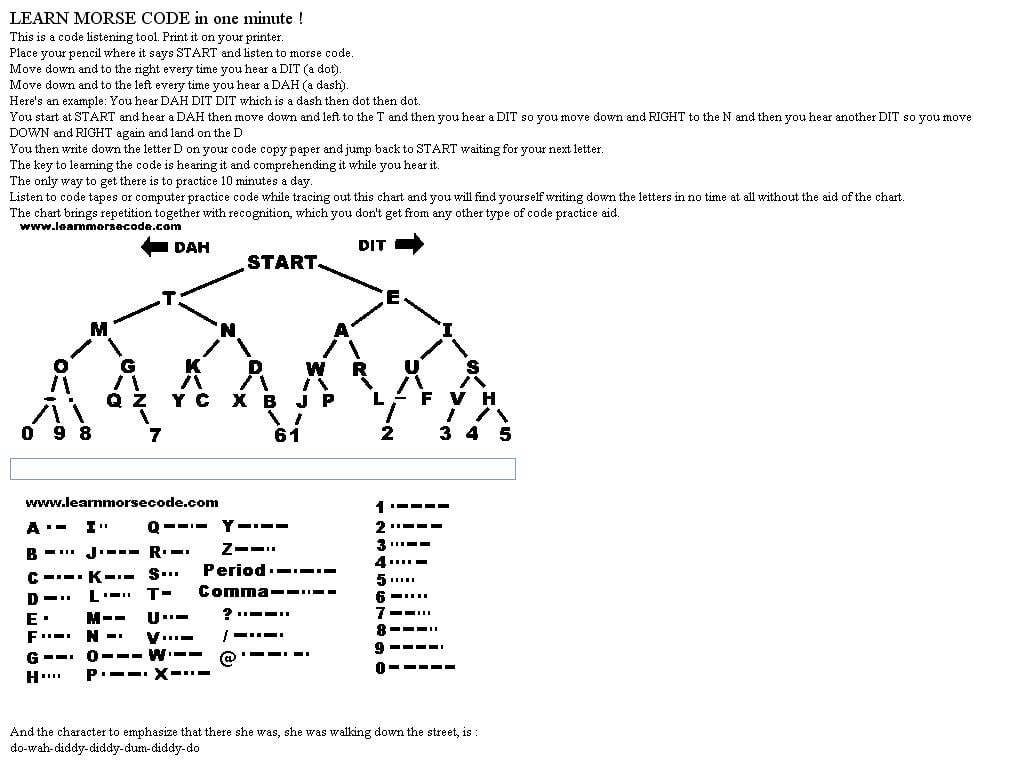I never realized morse code was organized as a binary tree, this makes it much faster to figure out which letter the code meant
Cool Guides
Rules for Posting Guides on Our Community
1. Defining a Guide Guides are comprehensive reference materials, how-tos, or comparison tables. A guide must be well-organized both in content and layout. Information should be easily accessible without unnecessary navigation. Guides can include flowcharts, step-by-step instructions, or visual references that compare different elements side by side.
2. Infographic Guidelines Infographics are permitted if they are educational and informative. They should aim to convey complex information visually and clearly. However, infographics that primarily serve as visual essays without structured guidance will be subject to removal.
3. Grey Area Moderators may use discretion when deciding to remove posts. If in doubt, message us or use downvotes for content you find inappropriate.
4. Source Attribution If you know the original source of a guide, share it in the comments to credit the creators.
5. Diverse Content To keep our community engaging, avoid saturating the feed with similar topics. Excessive posts on a single topic may be moderated to maintain diversity.
6. Verify in Comments Always check the comments for additional insights or corrections. Moderators rely on community expertise for accuracy.
Community Guidelines
-
Direct Image Links Only Only direct links to .png, .jpg, and .jpeg image formats are permitted.
-
Educational Infographics Only Infographics must aim to educate and inform with structured content. Purely narrative or non-informative infographics may be removed.
-
Serious Guides Only Nonserious or comedy-based guides will be removed.
-
No Harmful Content Guides promoting dangerous or harmful activities/materials will be removed. This includes content intended to cause harm to others.
By following these rules, we can maintain a diverse and informative community. If you have any questions or concerns, feel free to reach out to the moderators. Thank you for contributing responsibly!
I think if you take any set of symbols and map each one to a unique binary sequence, you can then structure it as a binary tree.
In other words Morse didn't have to be designed as a tree. The tree is just a data structure that fits any similar abstraction. You could probably do something similar with a multidimensional array (5D to include punctuation) but that's much harder to illustrate.
Yes, but it is designed that way so that the most common letters take less dits and dad's to encode. That reduces the overall work.
Well, you only got 2 symbols, so binary, and you want to minimize the symbols used for the whole alphabet+numbers. That naturally will give you a binary tree.
This is one of the best cool guides I have ever come across. Simple and efficient! Good job!
This is also an extremely difficult way to learn Morse code. No one that actually knows Morse code will ever use a chart like this in their thinking and listening pattern.
You're right, and your post needs to be seen more. Learn Morse audibly, not visually. Whenever I see someone post about these charts it instantly tells me that they don't actually use Morse.
Learning Morse visually means you have to decode it with more steps:
hear code --> visualise the sound --> decode to letter
Decoding by ear is the fastest way, and is the way that Morse operators decode it (eventually you just hear words).
hear code --> decode to letter.
Here is a useful website for learning Morse code: https://lcwo.net/
There's also Morse Trainer on f-droid for those that are app inclined.
Learn in one minute, but only if you practice 10 minutes per day!
I do love the nod to Short Circuit at the end though.
I would like to add:
DAH DAH DIT DAH DAH, DIT DAH DAH DAH DAH
This is amazing, but if I came up with something like this and I showed somebody, they'd have me institutionalized.
I understand why the period is a 6-sound sequence (the complexity is organized by how common the character is in use), but it bothers me that it isn't just a single "dit".
That is pretty cool
This is brilliant, thank you!
the most important one to learn is SOS ...---...
I guess the symbols aren't standard? The ones on the bottom table don't match with the ones in the tree
Which ones don’t match?
So most of the symbols on the bottom are not on the chart st the top. However, the period is listed at dot dash dot dash dot dash, but the chart would make it dash dash dash dot.
DahDahDahDit has no character listed on the tree. It decodes as "Ó" (with the diacritical) in some translators.
Two other symbols (DahDahDahDah and DitDitDahDah) also have no character mapped. In some translators, they decode to "Ĥ" and "Ü", respectively, but those characters are not used in English and are not listed on this tree.
Those positions are included in the tree only because they are steps to get to Zero (DahDahDahDahDah) and Two (DitDitDahDahDah)
The tree has no punctuation listed.
..-. .- .. .-. / .–. .- .- -.. / - — / -.– — ..-
I checked all of them, they all look to match to me.
